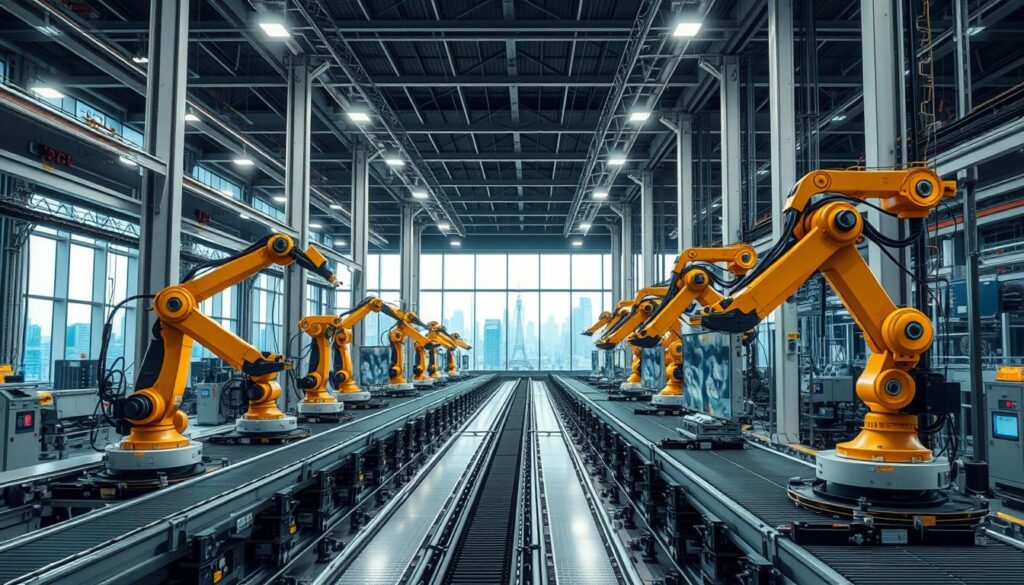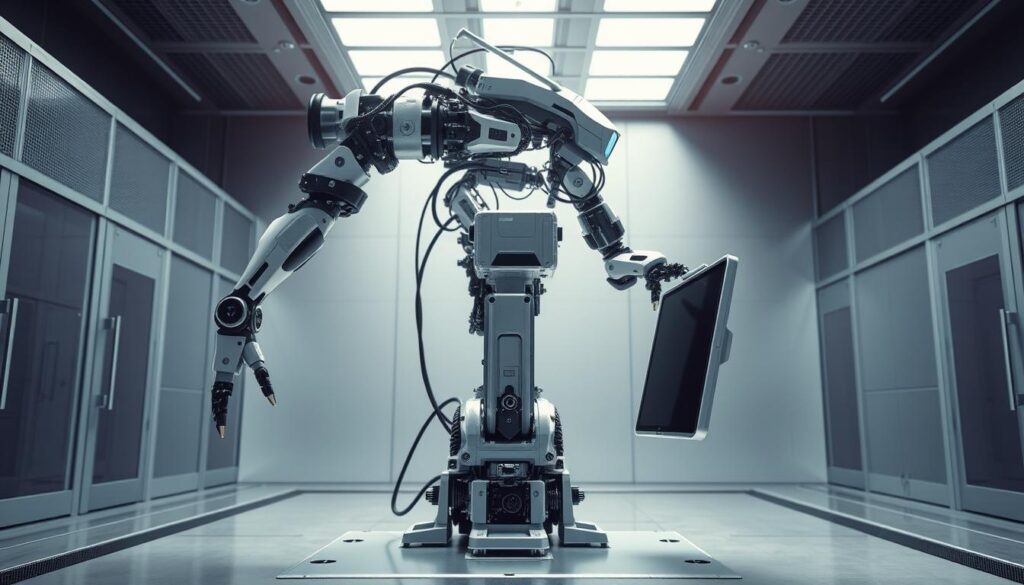In our world today, we’re seeing huge leaps in tech. Robotics stands out as a key area in this global race. Countries are crafting advanced strategies to excel in robotics. This is crucial for nations like India that want to lead in technology while facing stiff competition worldwide.
The push to create a strong innovation strategy comes from knowing the power of robotics. It can transform industries, change economies, and even alter how we work. Countries everywhere are gearing up. They know that success in robotics might set them apart in the international market.
- Key Takeaways
- Understanding Robotics and Its Global Impact
- Exploring Types of Robots and Their Applications
- The Role of Artificial Intelligence in Robotics Evolution
- Technological Trends Shaping Future Robotics
- Global Robotics National Strategy: An Overview
- National Policies and Frameworks Fueling Robotics Innovation
- Comparative Analysis: Robotics Development Roadmaps Worldwide
- Collaborative Robotics and Human-Robot Interaction
- Challenges and Solutions in Robotics National Strategy Implementation
- Investing in Robotics: Economic Implications and Opportunities
- Future of Automation and Robotics in Emerging Economies
- Conclusion
- FAQ
- What is the definition of robotics according to industry standards?
- How have advancements in AI and machine learning impacted robotics?
- In what ways is robotics reshaping industries and workforce dynamics?
- What are the main differences between industrial robots and service robots?
- Why are medical robots becoming increasingly important in healthcare?
- What is the significance of AI in the evolution of robotics?
- How is the integration of IoT influencing robotics?
- What advancements are being made in autonomous systems and mobility?
- What underpins a successful global national robotics strategy?
- How are workforce development strategies crucial to the robotics sector?
- What can we learn from the leading robotics nations in the world?
- What is the role of collaborative robots in the industry?
- What challenges need to be addressed in implementing national robotics strategies?
- Why is the private sector and venture capital investment important for robotics?
- How does robotics innovation affect economic growth and job creation?
- What should emerging economies consider when integrating robotics into their growth plans?
Key Takeaways
- Emerging influence of robotics national strategy in securing technological sovereignty
- Significance of staying ahead in global competition through advanced robotics
- Critical role of innovation strategy in propelling national industries
- Strategic importance of technology leadership in a globally connected market
- The need for a harmonized approach towards workforce development in robotics
Understanding Robotics and Its Global Impact
Robotics mixed with artificial intelligence is making huge steps forward around the world. This is leading to smarter automation systems everywhere. By following a detailed plan for robotics and sticking to industry rules, countries are boosting their own industries. They’re also making a mark on the world economy.

Definition and Scope of Robotics
Robotics involves designing, making, and using robots that can work in different places, like factories or hospitals. Nowadays, robotics is not just about machines doing physical jobs. It includes jobs that require thinking, thanks to machine learning and AI. This fits into a worldwide plan to lead in technology.
Advancements in AI and Machine Learning
The mix of smart algorithms and strong designs is changing what robots can do. AI in robotics now means robots can analyze complex data. They learn from what happens around them to get better at their jobs. This shows why it’s key to have policies that support fast growth and new ideas in automation.
Impact on Industries and Workforce Dynamics
Robotics is changing many industries and how we work. To grow economically with robotics, creating strong training programs for the workforce is crucial. Workers need new skills to do well in a world with more robots. As robotics spreads from making things to providing services, workers must be ready to team up with advanced robots.
Exploring Types of Robots and Their Applications
The world of robotics is wide and varied, with robots changing our lives in many ways. They play a big role in making industrial automation better. They also help a lot in healthcare. Let’s look at the main kinds of robots and how they are used.
Industrial Robots in Manufacturing
Industrial robots are very important in making things. They help make production faster and more precise. They are used for welding, putting things together, and moving materials. These robots are key in making the way we make things better and more modern.

Service Robots for Personal and Professional Use
Service robots are used in both our homes and at work. They show how automation in domestic environments has grown. We have robots that clean our floors and drones that keep us safe. The number of these robots is growing fast. They are becoming more useful in our daily lives, thanks to new ideas in robotics.
The Rise of Medical Robots in Healthcare
Robots in healthcare have changed how we do medical procedures and take care of patients. Medical robotics, a big part of healthcare automation, brings advanced tech to surgeries and other medical needs. Healthcare everywhere is starting to use these robots more. This helps ensure these tools meet the high needs of modern medicine.
The Role of Artificial Intelligence in Robotics Evolution
Exploring AI’s role in robotics shows us how it’s not just making robots better. It’s changing how industries and tech work. Robots now can make choices on their own, thanks to autonomous decision-making skills. This is key for jobs that need both accuracy and the ability to adjust. We’re committed to this mix of AI and robotics as part of a big digital transformation plan. This plan is set to change many areas from top to bottom.

The convergence of AI and robotics marks a big move towards smarter systems that can handle things by themselves and learn. This combo doesn’t just make things run smoother. It also creates new chances for cool robot projects. Making strong robotics technology policy is a big part of our work in technology policy development. We want AI and robotics to come together in a way that’s forward-thinking and sustainable.
By making and following smart policies, robots with AI can go beyond what we used to think was possible. They’re starting a new chapter for industries and how we live. Our digital transformation plan lays out how to bring AI into robotics. Everyone involved, from the ground up, can see how to make the most of these amazing tech combos.
Getting the most out of these updates means always learning and tweaking how robotic systems work. This keeps them leading in tech changes. They get better over time. Our goal is to keep the growth of AI and robotics moving. We’re doing this with informed robotics technology policy and solid technology policy development.
Technological Trends Shaping Future Robotics
Smart technology and strong research are moving robotics forward. We’re in a time where integrating IoT with robotics is crucial. It’s essential for creating smarter, efficient robots that are changing industries around the globe.
In our national robot plan, we focus on improving robot mobility. This makes robots more responsive and adaptable. It is key to a world-class robotics research framework that goes beyond current tech limits.

Robots are advancing fast in areas like farming, boosting sustainability and productivity. Thanks to IoT, robots can work on their own, making smart choices without us.
Internet of Things (IoT) Integration
IoT is making robots more connected, with constant data sharing. This lets robots adapt and monitor things closely, from homes to industries.
Advances in Autonomous Systems and Mobility
Improvements in robot mobility and autonomy are changing how robots are used. They can now handle difficult terrains and tasks, by themselves.
| Feature | Impact | Example |
|---|---|---|
| IoT Connectivity | Enhances real-time data processing and integration | Automated warehouses |
| Autonomous Navigation | Reduces human error and increases safety | Self-driving delivery vehicles |
| Advanced Mobility | Improves access and operational range | All-terrain exploration drones |
Our work in adding new tech meets the global goals in the national robotics implementation plan. We’re setting the foundation for the future of robotics.
Global Robotics National Strategy: An Overview
As digital times grow, countries see how vital a robotics national strategy is. They use a national innovation strategy to plan and push forward in robotics. This helps them keep up and shape the future of tech.

These strategies focus on government robotics initiatives. They aim for tech growth while keeping ethics in mind. This is key for security, economic progress, and better living for everyone.
For a robotics national strategy to work, it must inspire innovation. This means funding research, training workers, and making policies that help businesses. With all this, governments want to lead in robotics and set the pace for tech worldwide.
- Incentivizing private sector partnerships
- Streamlining regulations for robotic deployment
- Enhancing public awareness and education on robotics
By putting these plans into action, countries boost their tech abilities and add to global innovation. The growth of government robotics initiatives shows a future rich with robotics and AI. This makes having a solid national innovation strategy more crucial than ever.
National Policies and Frameworks Fueling Robotics Innovation
Government investment in robotics is transforming the industry. It’s creating big changes and new opportunities in many fields. By focusing on a national robotics plan, we’re improving now and planning for robots in our future.
Robotics Policy Initiatives are key to this growth. They aim to make rules that keep robotics safe, creative, and ethical. This kind of leadership is essential. It helps technology grow in a way that’s good for everyone.
The following table shows how national policies are pushing robotics forward:
| Policy Initiative | Description | Impact |
|---|---|---|
| Increased Funding for Robotics | Allocating larger budgets towards research and development in robotics technology. | Accelerates innovation and adoption of advanced robotics technologies. |
| Streamlined Robotics Regulations | Simplifying the regulatory process to facilitate faster integration of robotics into commercial sectors. | Reduces barriers for robotics deployment, allowing quicker market entry. |
| Robotics Workforce Training | Programs designed to skill the workforce in managing and working alongside robotics systems. | Ensures a well-prepared workforce capable of driving robotics-led industrial growth. |
Renewing robotics education curriculum is also crucial. It prepares future tech leaders by giving them the skills for innovation. This goes hand in hand with boosting workforce training in robotics. Together, they ensure everyone benefits from robotics tech.
The government investment in robotics is vital. It funds new research and supports partnerships between public and private sectors. Such strategies help keep our nation competitive and innovative in the global robotics scene.
In wrapping up, federal support and tech advances are shaping a future rich with robotics. With focused robotics workforce training and a clear national robotics roadmap, we’re building a world that’s ready for the advancements of tomorrow. This direction promises smart solutions for future challenges.
Comparative Analysis: Robotics Development Roadmaps Worldwide
Exploring the different strategies in robotics innovation globally shows us the importance of national plans. Countries share some goals but also have unique methods to boost the robotics industry. This analysis helps us understand how countries craft policies to advance in technology, affecting the world.
Looking at how leading robotics countries adapt their policies to new technological changes is enlightening. These policies help local industries grow and serve as models for others. Emerging robotics centers can use these insights to speed up their own development. They can create effective national plans to push the growth of their robotics sectors.
Case Studies of Leading Robotics Nations
We looked at Japan, Germany, and South Korea for their strong robotics strategies. Their plans focus on innovation, funding, and collaboration with academia. This is key for staying competitive globally.
Japan stands out for its integration of robotics in their industrial strategy. This has led to big advancements in robotics. Germany, with its focus on training, continues to lead in robotics, thanks to its engineering history.
Lessons and Insights for Emerging Robotics Hubs
Emerging robotics areas can learn a lot from these countries. Their constant policy updates ensure ongoing improvements in robotics. Education is also made a priority to grow a skilled workforce.
For upcoming robotics sectors, it’s vital to have a broad policy. It should cover funding, innovation, education, and international ties. These aspects are crucial for a strong and creative robotics industry.
Read more: What are Autonomous Agents? Complete Guide 2024
Read more: Remote Ready: Essential Tools for New Work-from-Home Jobs
Read more: Computer vision Master Guide 2025
In the end, the achievements of top robotics nations show a clear way forward for newbies. Understanding how policy, innovation, and education work together is key. This will help new markets compete on the global stage.
Collaborative Robotics and Human-Robot Interaction
In the heart of modern industrial progress, cobots shine as a major leap forward in human-robot teamwork. These advanced machines are built to work right next to humans. They boost productivity and keep workers safe by following safe robotics implementation rules. Cobots are becoming widespread thanks to the national robotics plan. This plan encourages a world where people and robots work hand in hand without any problems.
We’re in line with government goals that push for more use of collaborative robots in important fields. These government initiatives in robotics help in studying and using cobots in various industries. They highlight how important it is for our country to lead in robotic innovation. Being part of the robotics innovation program helps us move forward in using robots safely and efficiently. This sets us apart in how we team up with robots.
Looking closely at these advances, we see how cobots change our work lives and make them safer. When cobots are used in jobs needing high accuracy, they lessen the dangers humans might face. This action shows the value of safe robotics implementation. Adding cobots into our workplaces means we’re boosting, not replacing, human efforts. Cobots handle the tough tasks, cutting down on injuries and upgrading our skills.
Our path to more robot help in our industries and lives gets clearer thanks to smart human-robot interaction tactics. With the national robotics plan and government initiatives in robotics backing us up, we’re heading towards a future. In this future, cobots stand for both safety and high performance at work.
Challenges and Solutions in Robotics National Strategy Implementation
Implementing a national plan in robotics needs a careful balance. We have to overcome inside challenges and work with others outside. Dealing with the tough parts of robotics policy, we see two big issues. We must push tech forward and meet global tech standards. We’re working to get more money for robotics research. This helps us beat these challenges and boosts our tech independence and economic strength.
When it comes to robotics policy, tech policy barriers stand out. Taking robotics hardware to market and scaling up needs careful planning. We can’t rely too much on big international tech companies. Our robotics plan has to tackle these tech problems and also fit with world tech standards. This will help us work together better on global robotics projects.
Working together on international robotics is more than just agreements. We need strong rules for working together that work across countries. This is key to competing globally. By cooperating internationally, we boost innovation. We help develop advanced robotics technologies.
| Challenges | Solutions |
|---|---|
| Technological Barriers in Hardware Scale-up | Enhanced Robotics Research and Development Funding |
| Dependence on International Robotics Hardware | Fostering Domestic Production Capacities |
| Lack of Global Technology Standards | Advocating for International Robotics Cooperation |
We must keep refining our robotics strategies. This means always reviewing and tweaking our robotics policy. This way, our national robotics plan stays up-to-date. It will meet our country’s needs and keep up with world tech changes.
Investing in Robotics: Economic Implications and Opportunities
Technology’s growth has made robotics key in pushing the economy forward. With lots of funding in robotics and AI, we’re entering a new phase. Here, the chances to make money through robotics are quickly increasing. This money boost helps the robotics field grow and changes how we see automation’s economic role.
Money from businesses and investment groups is improving tech abilities. This leads to more growth in the robotics field and many economic chances.
When businesses get involved, they keep bringing new ideas to life. This, with the help of AI investments, allows startups to create new robotic tools. These innovations then help the job market and promote economic growth.
The way automation changes jobs is heavily influenced by using more robots. Putting money into robotics changes how we make things, boosts efficiency, and creates jobs that need new skills. As robots become more common, many traditional jobs change, showing the need to learn new skills.
Indeed, putting money into robotics doesn’t just help the robotics sector. It also speeds up economic development for everyone. This mix of investing in tech and planning economically promises a bright future for our economy, both nationally and globally.
Future of Automation and Robotics in Emerging Economies
The use of robots is key for the growth of technology and economy in developing places. As countries like the US move fast in automation, emerging economies must also step up. They need good plans for using robots to keep up with the world.
Using robot tech is crucial and gives these countries an edge. By learning from the tech growth in other places, they can improve a lot. This includes making better their manufacturing, healthcare, and services. We’ll look at how some countries have succeeded and the hurdles they’ve met.
Adaptation Strategies for Developing Countries
For success in robotics, nations must focus on three things: education, infrastructure, and making good policies. They need educational programs that make people skilled, strong tech setups, and helpful laws. These steps help make sure that using robots really makes life better and grows the economy.
Case Studies: Success Stories and Challenges
Many countries are doing well with robots, increasing how much they make and how well they work. But, there are also big hurdles like the high cost of robots, not enough experts, and people being wary of new tech.
| Country | Success Factor | Challenge |
|---|---|---|
| Brazil | Increased productivity in automotive manufacturing | High cost of robotic systems |
| India | Advancement in remote surgical procedures | Insufficient skilled robotics professionals |
| Nigeria | Improved agricultural outputs through drone technology | Integration of technology with traditional practices |
By studying these examples, developing countries can plan better. They can overcome challenges and use robot strategies to grow economically.
Conclusion
When we think about the future of robots, it’s clear that a strong national plan is key. This plan shapes how we use robots worldwide. It brings together technology and government rules in a big way. This changes how industries and communities work for the better.
Plans from countries are like guides for making a future where robots are part of everyday life. By putting money into research and teamwork between schools and businesses, countries can lead in innovation. The most exciting part is seeing how these plans could change our lives. They could change everything from making things to healthcare, making sure robots help us all.
These plans will keep being important for how countries compete and work together in robotics. By planning carefully, investing, and working with others, countries can lead in robotics. This work could change how we live with technology. As we move forward, we’re not just watching the change—we’re helping make it. We’re working towards a future where people and robots work together for a better world for everyone.
Outbound Link :
FAQ
What is the definition of robotics according to industry standards?
Robotics deals with creating and using smart machines for different tasks. These tasks can be in many settings.
How have advancements in AI and machine learning impacted robotics?
AI and machine learning have made robots smarter. Now, they can better understand and perform tasks. This has improved object recognition and control systems hugely.
In what ways is robotics reshaping industries and workforce dynamics?
Robotics is changing many industries like manufacturing and healthcare. It demands new skills for working with robots. Also, it’s making job roles evolve and production processes more efficient.
What are the main differences between industrial robots and service robots?
Industrial robots work in places like factories, doing tasks such as welding. Service robots help in homes and workplaces with chores or professional tasks.
Why are medical robots becoming increasingly important in healthcare?
Medical robots are key in healthcare for tasks like surgery. They are precise, reliable, and work well in sensitive spots. This is making healthcare better.
What is the significance of AI in the evolution of robotics?
AI helps robots do complex tasks on their own, react to changes, and improve from experience. It makes robots more useful by helping them understand their environment.
How is the integration of IoT influencing robotics?
The IoT makes robots smarter by improving how they gather and use data. This leads to more connected and clever robotic systems, enhancing user experience.
What advancements are being made in autonomous systems and mobility?
New tech in fields like farming and shipping has made work safer and more efficient. Robots and drones now do tasks on their own, tailored to specific industries.
What underpins a successful global national robotics strategy?
Good national robotics plans set big goals for using robots wisely. They invest in innovation and make policies for economic growth, safety, and improving life.
How are workforce development strategies crucial to the robotics sector?
It’s important to teach people how to work with robots. This means new training programs and updated education to keep the industry growing and leading technologically.
What can we learn from the leading robotics nations in the world?
Learning from top robotics countries shows effective ways to innovate and use robots. Their stories offer helpful lessons and highlight possible hurdles for others.
What is the role of collaborative robots in the industry?
Cobots are made to work safely with humans, helping and improving safety. They play a big role in tasks needing high skill, such as programming.
What challenges need to be addressed in implementing national robotics strategies?
Setting up robotics plans means tackling issues like making hardware widespread, working together globally, and setting common standards. This aims for worldwide success and leadership in tech.
Why is the private sector and venture capital investment important for robotics?
The private sector and investors push robotics forward by funding new ideas. Their support spurs innovation, helping the robotics field grow and mature.
How does robotics innovation affect economic growth and job creation?
Robotics brings economic growth by creating jobs and changing old ones. It needs new skills, affects various sectors, and makes the job market evolve.
What should emerging economies consider when integrating robotics into their growth plans?
Emerging economies should plan carefully for using robotics by learning effective strategies and considering global challenges. This can boost their tech use and economic growth.
Get in Touch with SJ Articles
Read more: Antiquantum Encryption in 2025: Essential Facts You Need to Know
Read more: Memory centric Computing Systems: Whats Old Is New Again
Read more: Neuromorphic Computing | How Does It Work?


